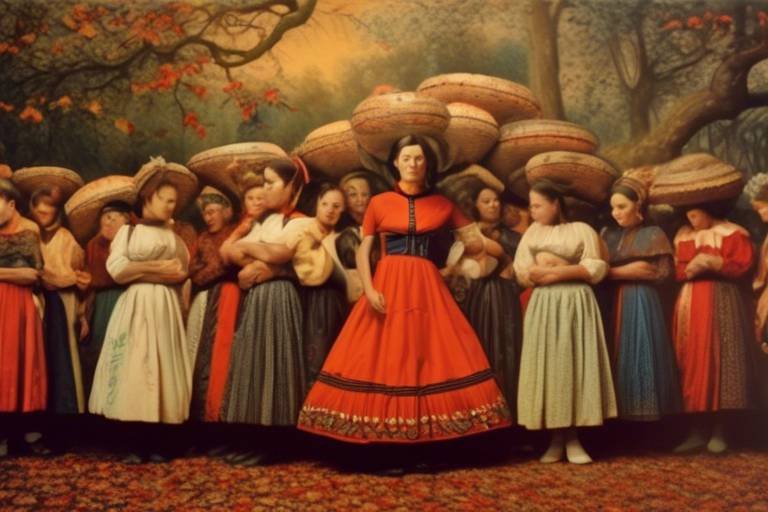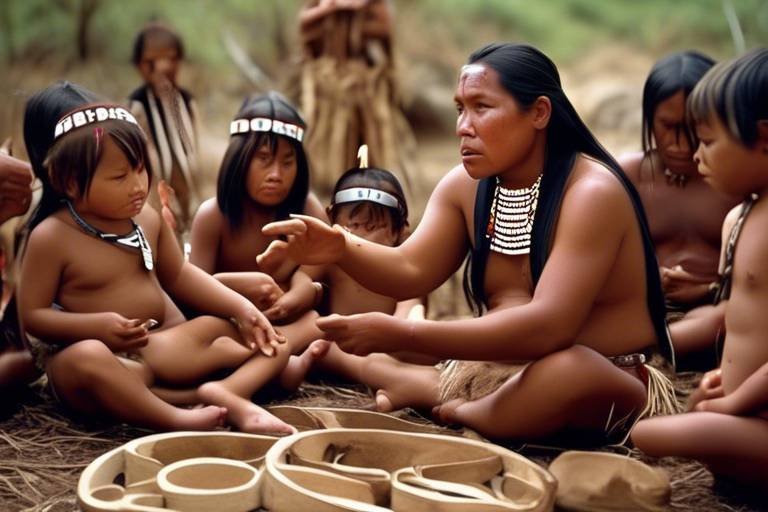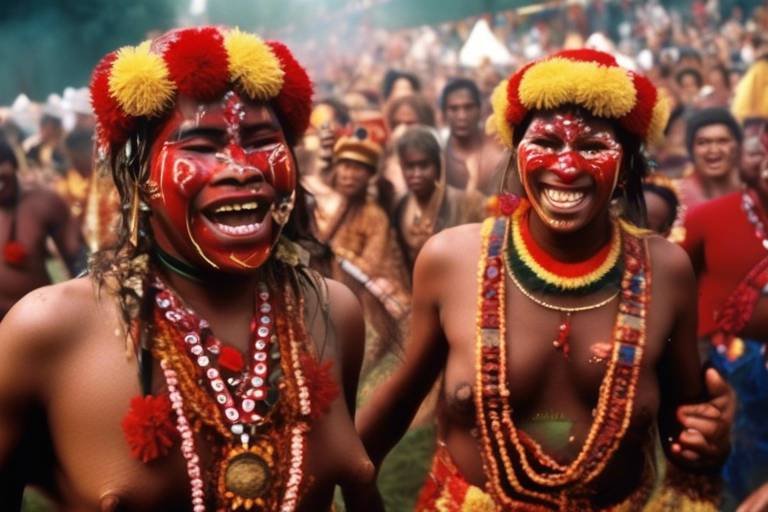The Role of Women in the Arts Throughout History
Women have played a crucial role in shaping the artistic landscape throughout history, making significant contributions across various art forms and challenging societal norms along the way. From ancient artistic traditions to contemporary expressions, women have defied expectations and made their mark on the world of arts.
In ancient times, women participated in art forms such as pottery, weaving, and storytelling, showcasing their creativity and cultural significance within early societies. These women contributed to the preservation of traditions and the transmission of cultural narratives through their artistic endeavors.
During the Renaissance period, female artists like Sofonisba Anguissola and Artemisia Gentileschi emerged, facing challenges in gaining recognition in a predominantly male art world. Despite these obstacles, these women artists produced remarkable works that continue to inspire and influence artists today.
The Victorian era brought forth gender constraints that limited women artists' opportunities for artistic expression. Societal expectations and norms influenced the subjects and styles of art created by women during this period, reflecting the prevailing attitudes towards gender roles.
In the Modernist movement, female innovators such as Georgia O'Keeffe and Frida Kahlo broke boundaries and redefined artistic conventions, challenging gender stereotypes through their bold and innovative artworks. These women paved the way for future generations of artists to explore new possibilities in art.
Contemporary women artists continue to address issues of gender, identity, and representation in their creative practices, infusing their works with feminist perspectives and pushing boundaries in the art world. Their diverse voices and perspectives enrich the artistic discourse and contribute to a more inclusive and diverse cultural landscape.
Women have also made significant contributions to the performing arts, excelling in fields such as theater, dance, and music. From Shakespearean actors to modern-day choreographers and composers, women have left an indelible mark on performing arts traditions, showcasing their talent and creativity on stage and beyond.
Furthermore, women have played crucial roles as art patrons and collectors, supporting artists, preserving cultural heritage, and shaping art markets throughout history. From medieval noblewomen to modern philanthropists, women have wielded influence in the art world through their patronage and advocacy for the arts.
Despite progress, women in the arts continue to face challenges related to representation, equality, and diversity. The ongoing struggle for recognition and equal opportunities underscores the importance of continued advocacy for gender parity and inclusivity in the arts, ensuring that women's voices are heard and celebrated in the artistic community.

Ancient Artistic Traditions
Exploring the significant contributions, challenges, and impact of women in various art forms across different time periods, shedding light on their roles in shaping cultural narratives and artistic expressions.
Women have played a vital role in ancient artistic traditions, contributing to the rich cultural tapestry of early societies. In the realms of pottery, weaving, and storytelling, women showcased their creative talents and cultural significance. Through intricate pottery designs, elaborate textile creations, and captivating oral narratives, women in ancient times left a lasting imprint on the artistic landscape of their communities.
One fascinating aspect of ancient art is the symbolic meanings embedded in women's creations. From the intricate patterns woven into textiles to the motifs adorning pottery, each piece carried deeper cultural significance. Women artists of the past were not merely craftswomen but storytellers, passing down traditions and beliefs through their art.
Moreover, the collaborative nature of ancient artistic practices allowed women to bond with their communities through shared creative experiences. Whether working together on a communal pottery project or weaving a ceremonial garment, women in ancient societies found a sense of belonging and connection through their artistic endeavors.
While women's contributions to ancient art forms may have been underrepresented in historical records, archaeological discoveries continue to unveil the hidden stories of female artists from the past. These revelations serve as a testament to the enduring legacy of women in shaping artistic expressions and cultural narratives throughout history.
Stay tuned for the FAQ section at the end of this article, where we address common queries about the role of women in the arts and their impact on artistic traditions.

Renaissance Women Artists
During the Renaissance period, a time known for its flourishing artistic expression and cultural rebirth, women artists faced unique challenges as they navigated the male-dominated art world. Despite societal norms that often restricted women's access to artistic training and professional opportunities, a few remarkable female artists managed to break through these barriers and make significant contributions to the artistic landscape of the time.
One notable figure from this period is Sofonisba Anguissola, an Italian painter who gained recognition for her portraits and genre scenes. Anguissola's talent and determination allowed her to establish herself as a respected artist, earning the patronage of prominent figures such as the Spanish court. Her success paved the way for future generations of women artists to pursue their artistic ambitions.
Another influential artist of the Renaissance era was Artemisia Gentileschi, an Italian Baroque painter known for her powerful depictions of biblical and mythological subjects. Despite facing personal and professional challenges, including a highly publicized rape trial, Gentileschi's artistry and resilience solidified her reputation as one of the most accomplished painters of her time.
These Renaissance women artists not only demonstrated exceptional skill and creativity in their work but also challenged the prevailing gender norms of their era. Through their perseverance and artistic innovation, they left a lasting legacy that continues to inspire and empower women in the arts today.

Victorian Era and Gender Constraints
During the Victorian era, women faced significant gender constraints that limited their participation and recognition in the art world. Society's rigid expectations and norms dictated that women should prioritize domestic duties over artistic pursuits, relegating them to the role of amateur hobbyists rather than serious artists. The prevailing belief that women were intellectually inferior to men further marginalized their creative endeavors, leading to limited opportunities for formal artistic training and professional advancement.
Female artists of the Victorian era often struggled to gain access to art academies and exhibition spaces dominated by male artists. Their works were frequently dismissed as mere imitations of male artistic styles, and their artistic achievements were overshadowed by their gender. Despite these challenges, some women artists managed to break through these barriers and achieve recognition for their talent and creativity, albeit within the constraints of societal expectations.
One notable example is the Pre-Raphaelite artist, Elizabeth Siddal, who defied societal norms by pursuing a career as a professional artist and model. Despite facing criticism and condescension from male artists, Siddal's unique artistic vision and determination paved the way for future generations of women artists to assert their presence in the male-dominated art world.
Moreover, the Victorian era saw the emergence of women writers and poets who used literature as a means of expressing their creativity and challenging gender norms. Writers such as the Brontë sisters and George Eliot (Mary Ann Evans) defied societal expectations by adopting male pseudonyms to ensure their works were taken seriously in a literary landscape dominated by men.
In conclusion, the Victorian era was a time of both constraint and defiance for women in the arts. Despite facing significant gender barriers and societal pressures, women artists and writers of this period made important strides in asserting their creative voices and challenging the status quo, laying the foundation for future generations of women to pursue artistic excellence on their own terms.

Modernism and Female Innovators
Modernism in the art world brought about a significant shift in artistic conventions, with female innovators playing a crucial role in challenging traditional norms and stereotypes. Artists like Georgia O'Keeffe and Frida Kahlo emerged as prominent figures during this period, breaking barriers and paving the way for future generations of women artists. O'Keeffe's abstract and vibrant depictions of nature captivated audiences, while Kahlo's introspective and surreal self-portraits delved into themes of identity, pain, and resilience.
These female artists not only made a mark through their unique artistic styles but also through their bold exploration of personal experiences and societal issues. O'Keeffe's larger-than-life flower paintings and desert landscapes challenged the male-dominated art world's perceptions of femininity and nature. On the other hand, Kahlo's raw and emotive artworks, influenced by her Mexican heritage and personal struggles, provided a voice for marginalized communities and sparked conversations about gender, politics, and cultural identity.
Moreover, female innovators in modernism not only created groundbreaking art but also actively participated in shaping the discourse around gender roles and artistic expression. Their contributions extended beyond the canvas, influencing art movements and inspiring future generations to embrace creativity and individuality. Through their resilience, passion, and unwavering dedication to their craft, these women carved out a space for themselves in an era dominated by male artists, leaving a lasting impact on the art world.

Contemporary Art and Feminist Perspectives
In the realm of contemporary art, women artists have been at the forefront of challenging societal norms and advocating for gender equality through their creative expressions. They use art as a powerful tool to address issues of gender, identity, and representation, bringing forth diverse perspectives and narratives that have long been marginalized. Through mediums such as painting, sculpture, performance art, and multimedia installations, these artists engage with feminist ideologies to provoke thought, spark conversations, and inspire change.
One notable aspect of contemporary art is the intersectionality of feminist perspectives, where artists explore the interconnected nature of gender with race, class, sexuality, and other social constructs. This approach allows for a more nuanced understanding of the diverse experiences of women and highlights the importance of inclusivity and intersectional feminism in artistic practices. By amplifying voices that have been historically silenced or overlooked, women artists in contemporary art challenge the status quo and push boundaries to create a more equitable and diverse art world.
Moreover, contemporary women artists often collaborate with feminist collectives, art institutions, and advocacy groups to create platforms for dialogue and activism. Through exhibitions, workshops, and public interventions, they engage with audiences to raise awareness about gender issues, promote social justice, and empower marginalized communities. By fostering a sense of solidarity and community, these artists pave the way for a more inclusive and equitable art ecosystem that values diversity, creativity, and social change.

Women in Performing Arts
Women have played a pivotal role in the performing arts throughout history, leaving a lasting impact on theater, dance, and music. From the iconic Shakespearean actors of the past to the contemporary choreographers and composers of today, women have continuously pushed boundaries and redefined traditions in the performing arts.
In the world of theater, women have not only graced the stage as talented performers but have also made significant contributions behind the scenes as playwrights, directors, and producers. Their influence can be seen in the diverse range of stories told on stage and the innovative approaches to storytelling that have captivated audiences for centuries.
Similarly, in the realm of dance, women have been at the forefront of shaping different dance styles and techniques, from classical ballet to modern and contemporary forms. Their creativity and artistry have brought forth new movements and expressions that have enriched the world of dance and inspired generations of dancers.
When it comes to music, women have excelled as composers, singers, instrumentalists, and conductors, breaking barriers and challenging stereotypes in a historically male-dominated field. Their talent and passion have produced timeless musical masterpieces and paved the way for future generations of female musicians to thrive.
Overall, women in the performing arts have not only showcased their immense talent and creativity but have also used their platforms to advocate for social change, challenge norms, and inspire audiences around the world. Their contributions have been instrumental in shaping the cultural landscape of the performing arts and continue to influence and inspire artists and audiences alike.

Women as Art Patrons and Collectors
Women have played a crucial role as art patrons and collectors throughout history, shaping the artistic landscape and preserving cultural heritage. From medieval noblewomen commissioning religious paintings to modern-day philanthropists supporting contemporary artists, women have wielded significant influence in the art world as patrons and collectors.
During the Renaissance period, noblewomen like Isabella d'Este of Mantua and Catherine de' Medici of France were renowned for their patronage of artists such as Leonardo da Vinci and Michelangelo, commissioning masterpieces that adorned their palaces and enriched the cultural fabric of their time.
In the 19th century, women like Peggy Guggenheim and Gertrude Stein emerged as prominent art collectors, fostering avant-garde movements like Cubism and Surrealism through their patronage of artists like Pablo Picasso and Salvador Dalí. Their support not only propelled these artists to fame but also helped shape the course of art history.
Women collectors have also played a vital role in preserving art collections and establishing museums for public enjoyment. The likes of Isabella Stewart Gardner and Doris Duke amassed impressive collections of art and antiquities, creating cultural institutions that continue to educate and inspire audiences to this day.
Moreover, women collectors have been instrumental in championing underrepresented artists and promoting diverse voices in the art world. Through their acquisitions and support, they have challenged traditional notions of art and expanded the boundaries of artistic expression.
Today, women continue to make significant contributions as art patrons and collectors, actively engaging with contemporary artists and investing in innovative projects that push the boundaries of creativity. Their influence extends beyond the walls of galleries and museums, shaping the discourse around art and fostering a more inclusive and diverse artistic community.

Challenges and Opportunities Today
In the contemporary art world, women continue to face various challenges and opportunities that shape their experiences and contributions. One of the persistent challenges is the issue of representation, as women artists are often underrepresented in major art institutions and galleries. This lack of visibility can hinder their recognition and limit their access to opportunities for showcasing their work to a wider audience. Additionally, the art world still grapples with issues of gender equality, with women artists frequently facing discrimination and unequal treatment compared to their male counterparts.
However, amidst these challenges, there are also significant opportunities for women in the arts today. The growing emphasis on diversity and inclusion in the art world has led to a greater recognition of the importance of amplifying diverse voices and perspectives, including those of women artists. Many organizations and initiatives now actively support and promote women in the arts, providing platforms for them to showcase their talent and connect with audiences worldwide.
Furthermore, the digital age has opened up new avenues for women artists to share their work and engage with a global audience online. Social media platforms and digital art marketplaces offer women artists the opportunity to bypass traditional gatekeepers and establish direct relationships with collectors, patrons, and art enthusiasts. This democratization of the art world has empowered women to take control of their artistic careers and reach a broader audience than ever before.
Overall, while challenges persist, women in the arts today have more opportunities than ever to make their mark and shape the future of artistic expression. By continuing to push boundaries, challenge stereotypes, and advocate for greater representation and equality, women artists are paving the way for a more inclusive and diverse art world that celebrates the unique voices and perspectives of all artists, regardless of gender.
Frequently Asked Questions
- 1. What role did women play in ancient artistic traditions?
In ancient times, women played crucial roles in art forms such as pottery, weaving, and storytelling. Their creative endeavors were integral to early societies, shaping cultural narratives and traditions.
- 2. Who were some notable female artists during the Renaissance period?
Notable female artists during the Renaissance included Sofonisba Anguissola and Artemisia Gentileschi. These women faced challenges in gaining recognition in a male-dominated art world but made significant contributions to the artistic landscape.
- 3. How did gender constraints affect women artists during the Victorian era?
During the Victorian era, women artists faced societal expectations and limitations that influenced their artistic pursuits. Gender norms often restricted their opportunities for recognition and success in the art world.
- 4. Which female artists made significant contributions to Modernism?
Female artists such as Georgia O'Keeffe and Frida Kahlo were instrumental in the Modernist movement. They challenged artistic conventions and gender stereotypes, redefining the boundaries of artistic expression.
- 5. How do women artists address feminist ideologies in contemporary art?
Women artists today often explore feminist ideologies in their work, addressing issues of gender, identity, and representation. Their creative practices reflect a commitment to challenging societal norms and advocating for equality.
- 6. What impact have women had on the performing arts throughout history?
Women have made significant contributions to theater, dance, and music, shaping performing arts traditions from Shakespearean times to modern-day productions. Their influence has been pivotal in evolving artistic expressions.
- 7. How have women contributed as art patrons and collectors?
Women have played vital roles as patrons and collectors of art, supporting artists, preserving cultural heritage, and shaping art markets. From medieval noblewomen to modern philanthropists, their impact on the art world has been profound.
- 8. What are some of the challenges and opportunities facing women in the arts today?
Today, women in the arts continue to navigate challenges related to representation, equality, and diversity. However, they also have opportunities to shape the future of artistic expression and influence cultural narratives in meaningful ways.



















